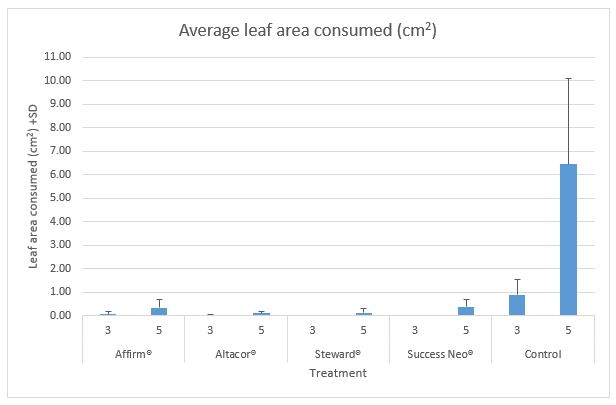As a part of a new insecticide resistance management strategy in grain crops, growers and agronomists are looking to rotate insecticides for Helicoverpa sp. control. Following enquiries from industry, DAF entomology have been conducting research on the range of newer insecticides available for controlling Helicoverpa larvae. In work previously published on the Beatsheet, we have demonstrated the efficacy of these products in controlling late instar larvae and identified the characteristic symptoms that occur during larval mortality from different products.
As this research indicated that larval growth is limited after pesticide ingestion, we recently conducted a trial examining how much plant material larvae consume after acquiring a dose of insecticide. In this experiment we compared the amount of herbivory inflicted on soybean leaves sprayed with commercial insecticides by small-medium (3rd instar) and large (5th instar) larvae against an untreated control.
We compared the following products:
- Affirm® (emamectin benzoate) 300 mL/ha + Pulse
- Altacor® (chlorantraniliprole) 70 g/ha + SpreadWet
- Steward® (indoxacarb) 300 mL/ha
- Success Neo® (spinetoram) 200 mL/ha
Results
Our results show that after being placed on sprayed leaves Helicoverpa larvae consumed a small amount of leaf material, which is necessary to ingest the insecticide. But after this, feeding ceases rapidly and larvae no longer pose a threat to the crop. As the amount consumed was so low that it is unlikely that any significant damage would be caused to buds, flowers or pods had we used any of these in the trial.

Figure 1: Soybean leaf area consumed by Helicoverpa armigera larvae 24-hours post spray. 1 cm2 of leaf equates to approximately 0.0156 g or 15.6 mg of plant material consumed.
All larvae on insecticide-sprayed leaves were moribund and had stopped feeding within 24 hours. In all treatments 5th instars consumed more than 3rd instars, which is consistent with prior knowledge that around 80% of total feeding damage is done in the last two instars (4th – 5th). There were no significant differences in the amount consumed among the insecticides (Figure 1).
3rd instar larvae consumed barely any leaf material before they ceased feeding (average of all insecticide treatments = 0.5 mg of leaf). Although 5th instars consumed more than 3rd instars, it was still a very small amount (average of all insecticide treatments = 3.8 mg). For both instars, control larvae consumed 26 times more leaf than the insecticide treatments. This result is visually evident in Figure 2.

Figure 2: Extent of leaf feeding by 5th instar larvae 24 hours after being placed on treated and untreated soybean leaves.
Note: when using these pesticides, ensure you comply with all relevant label requirements (which may vary from state to state).
This research has been conducted as part of project DAQ00196, supported by GRDC.
